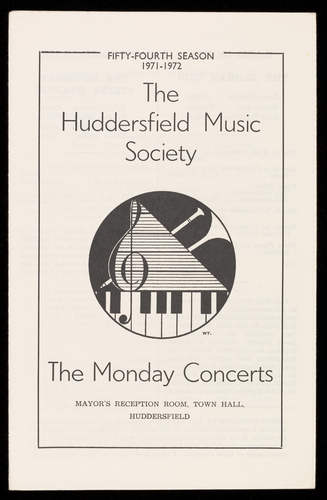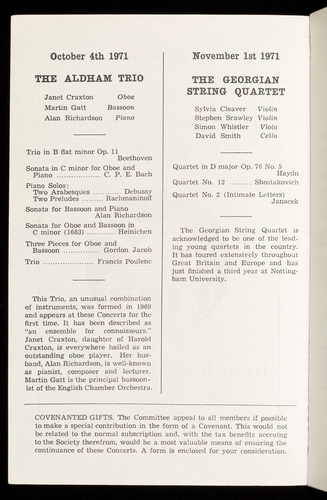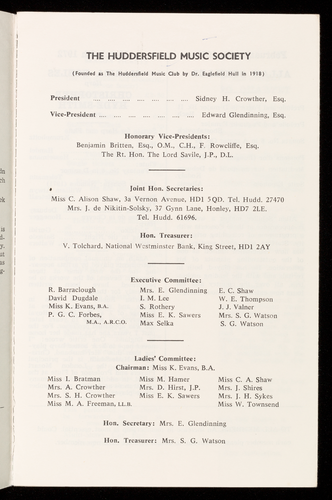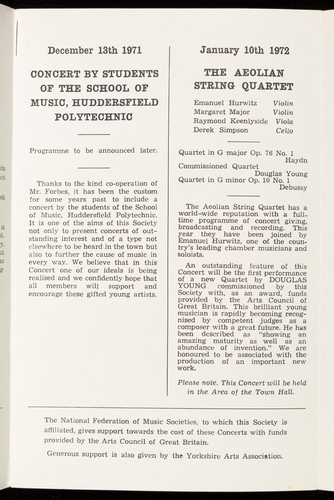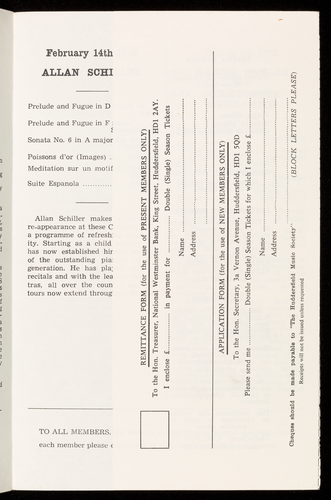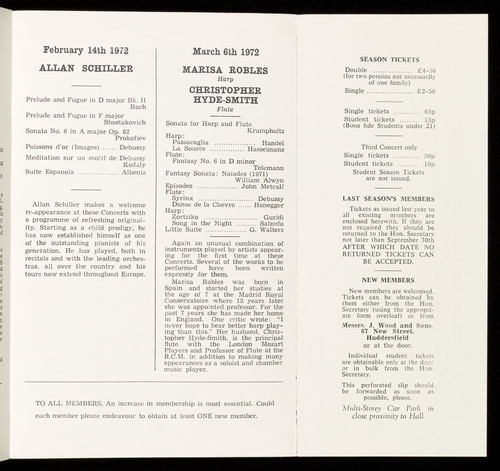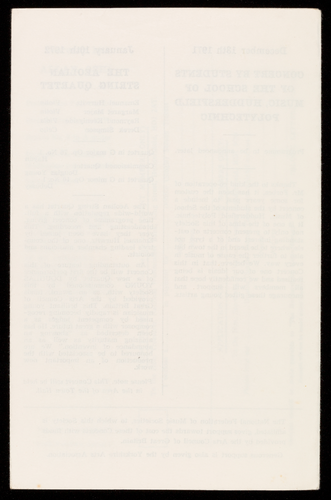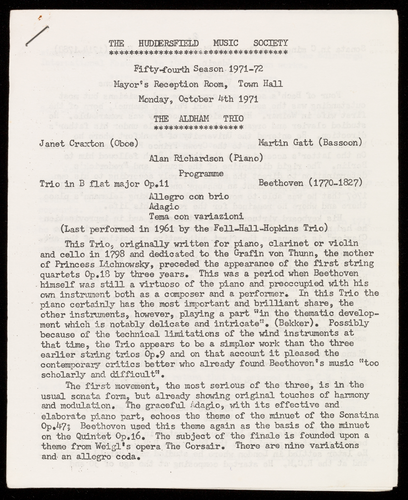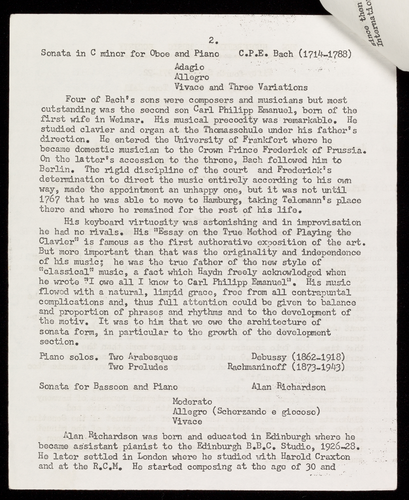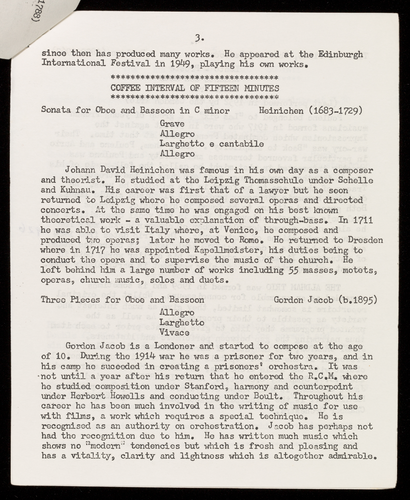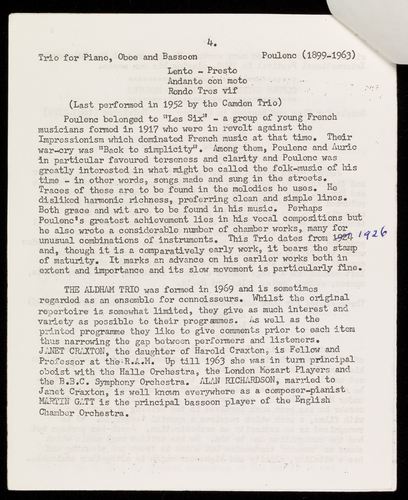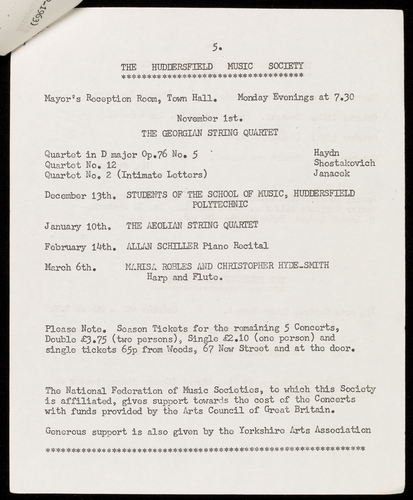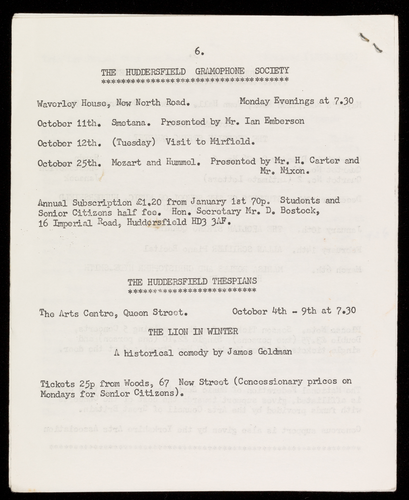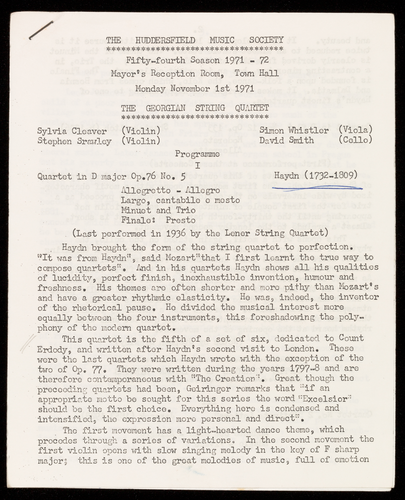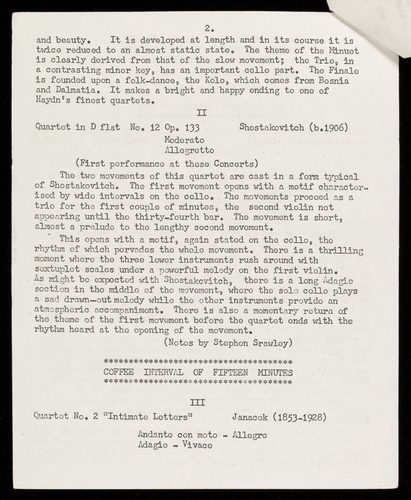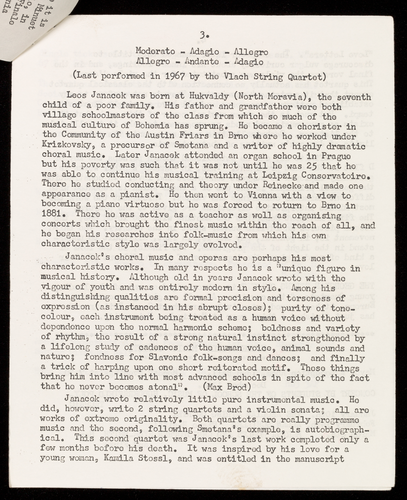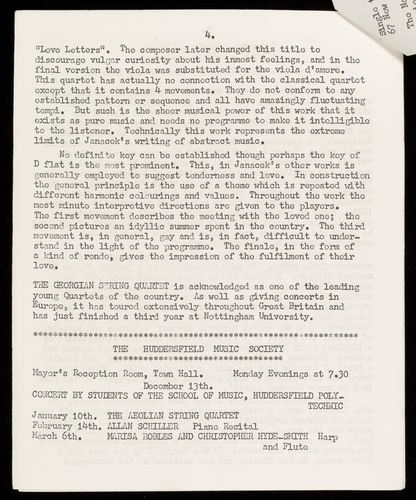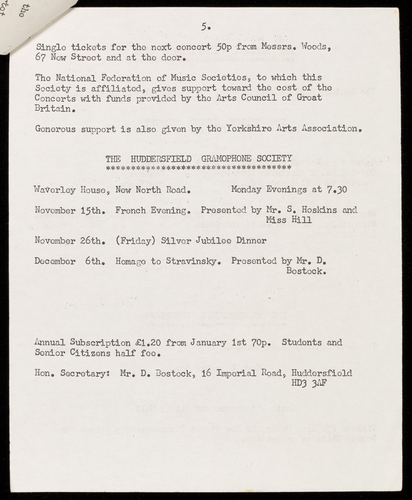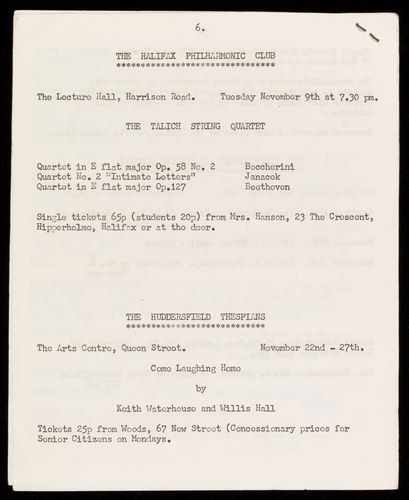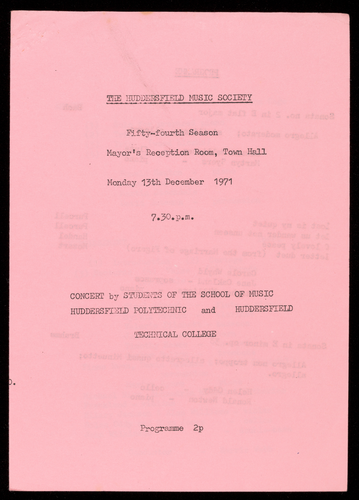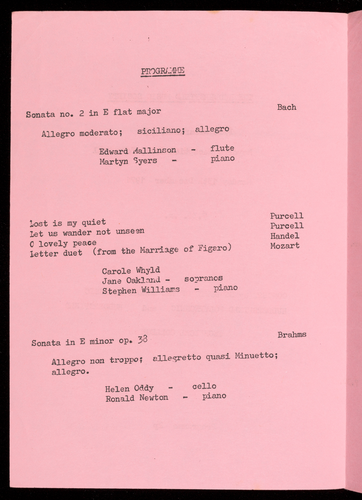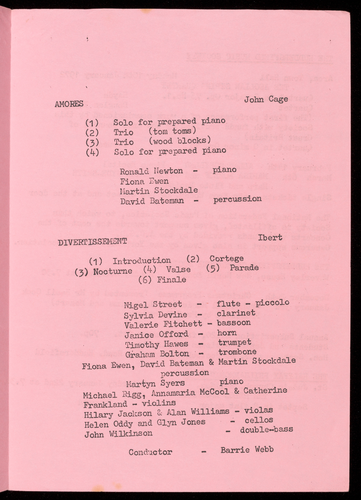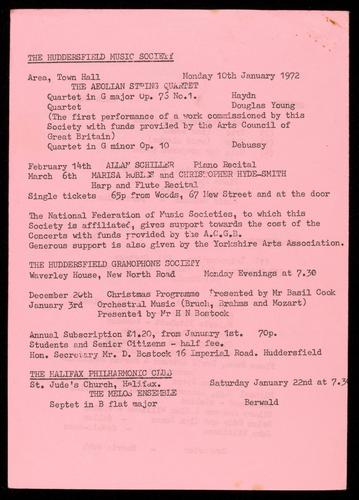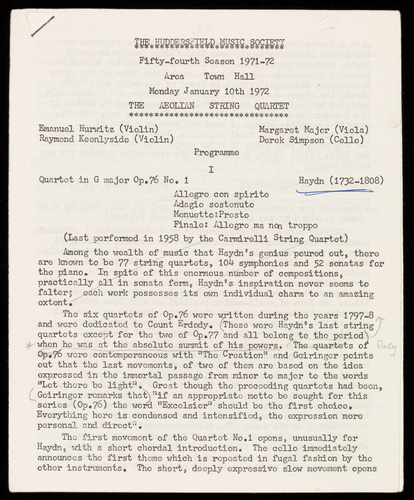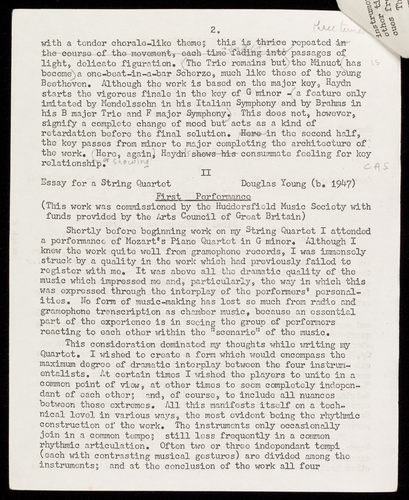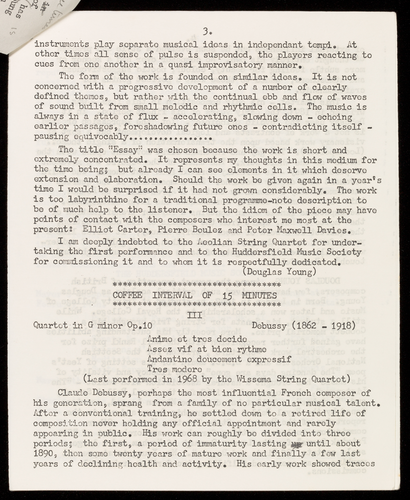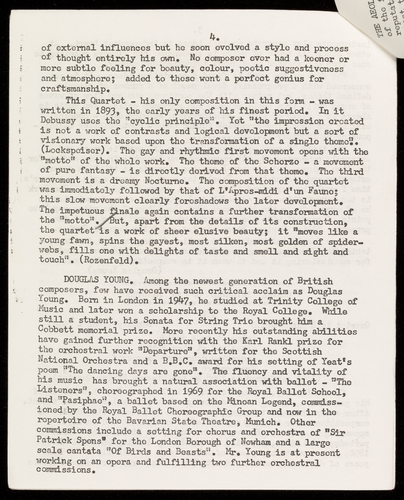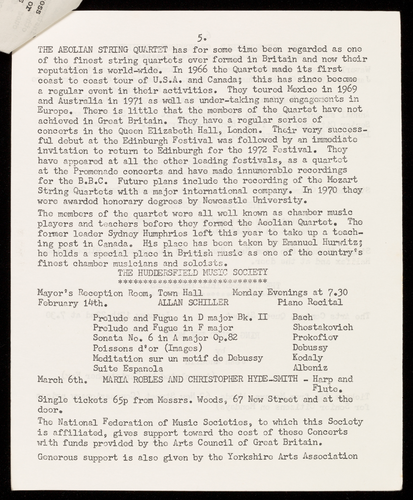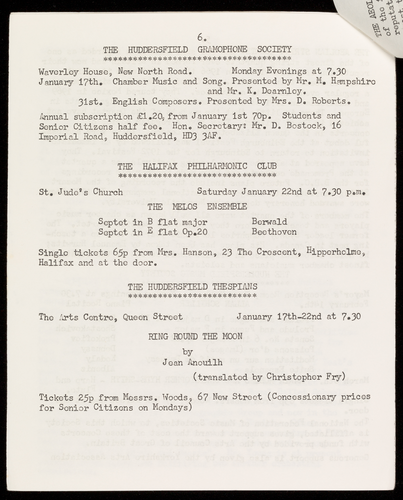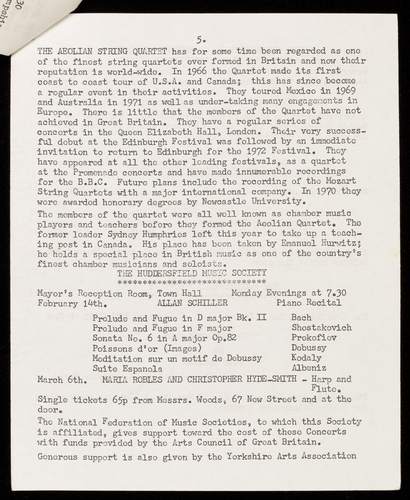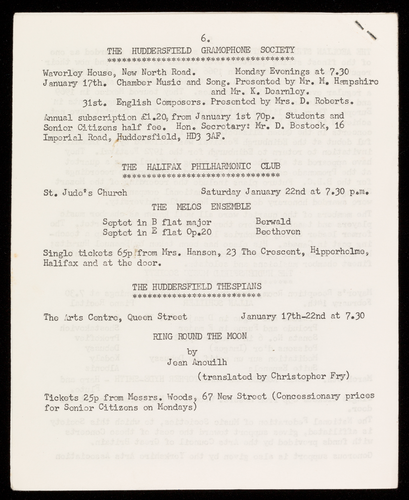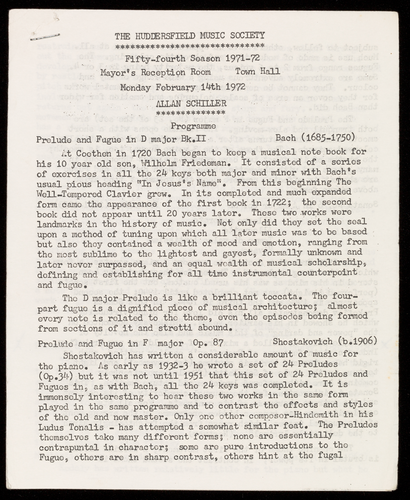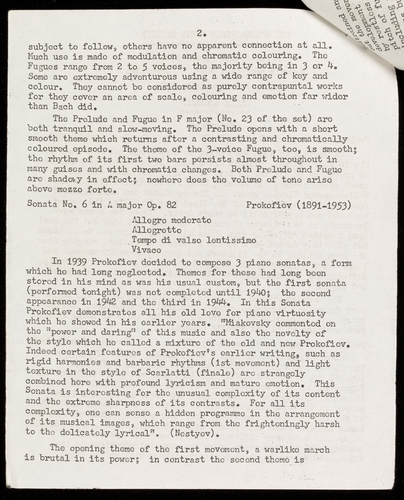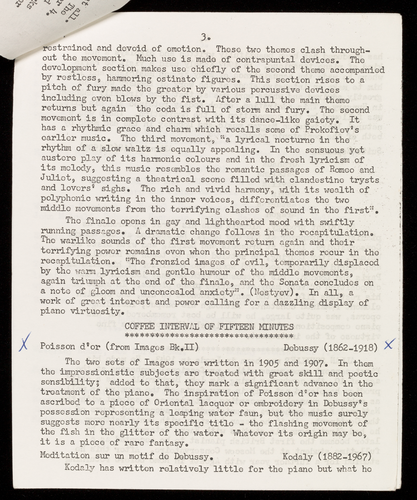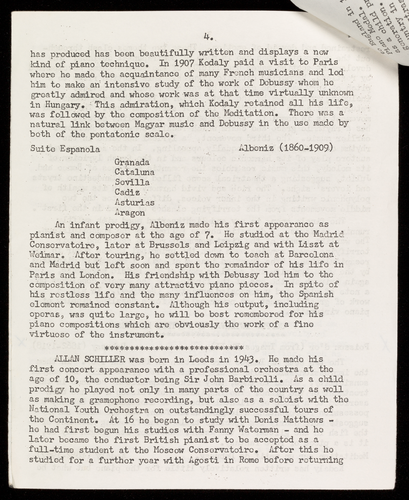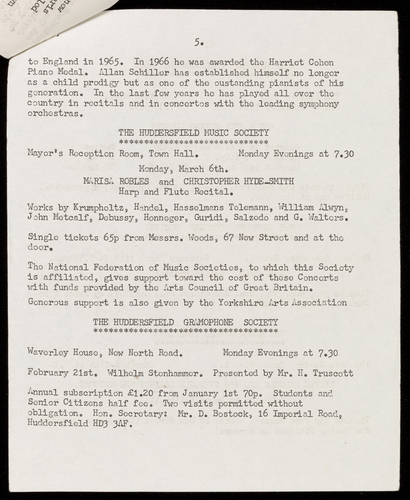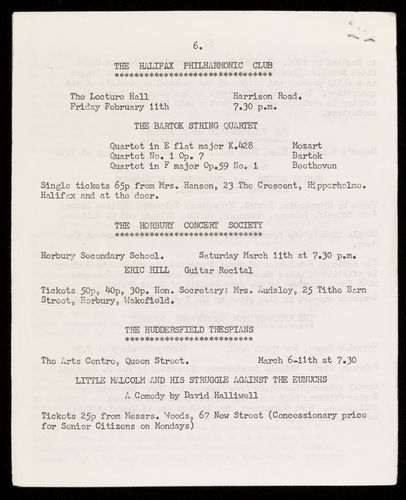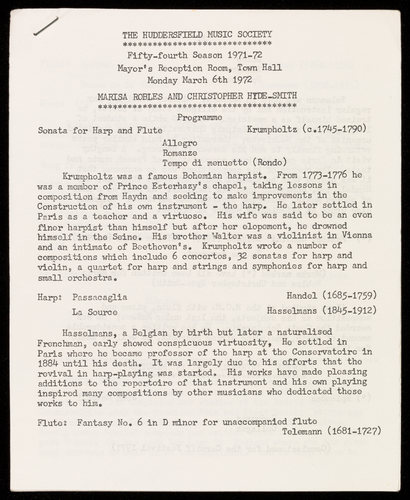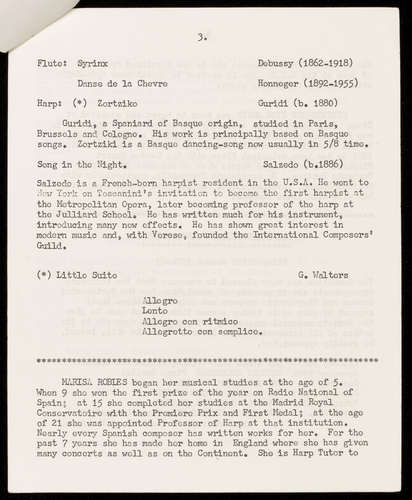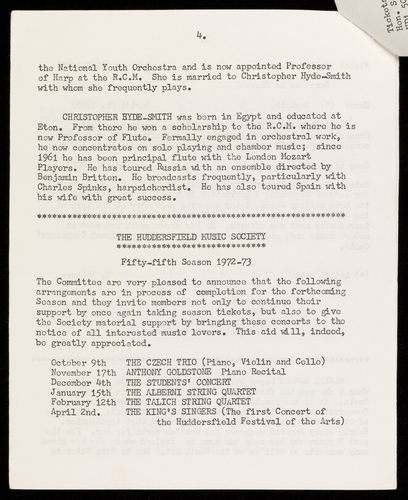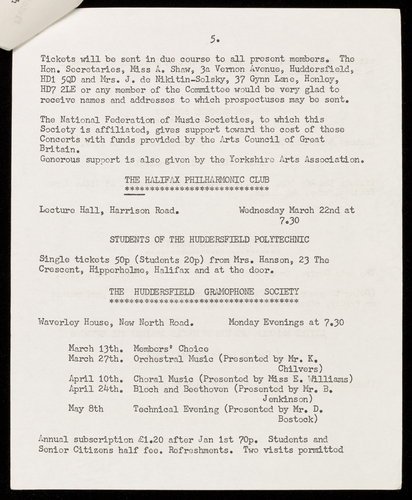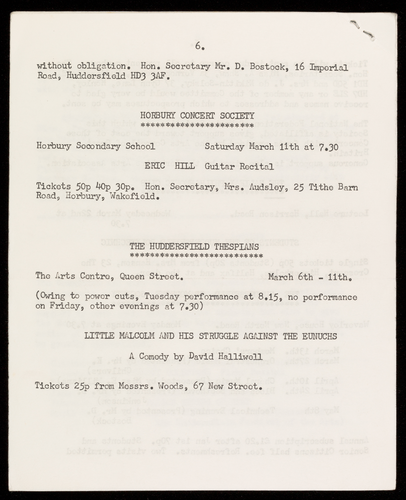Ocr'd Text:
FIFTY-FOURTH SEASON
1971-1972
The
Huddersfield Music
Society
11
WT.
The Monday Concerts
MAYOR'S RECEPTION ROOM, TOWN HALL,
HUDDERSFIELD
VO
1
HT
Ocr'd Text:
October 4th 1971
THE ALDHAM TRIO
Janet Craxton
Oboe
Martin Gatt
Bassoon
Alan Richardson Piano
Trio in B flat minor Op. 11
Sonata in C minor for Oboe and
Piano
Beethoven
C. P. E. Bach
Piano Solos:
Two Arabesques ..... .... Debussy
Two Preludes
Rachmaninoff
Sonata for Bassoon and Piano
Alan Richardson
Sonata for Oboe and Bassoon in
C minor (1683)
Three Pieces for Oboe and
Bassoon
Trio ......
Heinichen
Gordon Jacob
.... Francis Poulenc
This Trio, an unusual combination
of instruments, was formed in 1969
and appears at these Concerts for the
first time. It has been described as
"an ensemble for connoisseurs."
Janet Craxton, daughter of Harold
Craxton, is everywhere hailed as an
outstanding oboe player. Her hus-
band, Alan Richardson, is well-known
as pianist, composer and lecturer.
Martin Gatt is the principal bassoon-
ist of the English Chamber Orchestra.
November 1st 1971
THE GEORGIAN
STRING QUARTET
Sylvia Cleaver Violin
Stephen Srawley Violin
Simon Whistler
David Smith
Viola
Cello
Quartet in D major Op. 76 No. 5
Haydn
Quartet No. 12 ......... Shostakovich
Quartet No. 2 (Intimate Letters)
Janacek
The Georgian String Quartet is
acknowledged to be one of the lead-
ing young quartets in the country.
It has toured extensively throughout
Great Britain and Europe and has
just finished a third year at Notting-
ham University.
COVENANTED GIFTS. The Committee appeal to all members if possible
to make a special contribution in the form of a Covenant. This would not
be related to the normal subscription and, with the tax benefits accruing
to the Society therefrom, would be a most valuable means of ensuring the
continuance of these Concerts. A form is enclosed for your consideration.
Ocr'd Text:
dn
ch
ek
is
d-
y.
ut
as
g-
STOLTHE HUDDERSFIELD MUSIC SOCIETY O
(Founded as The Huddersfield Music Club by Dr. Eaglefield Hull in 1918)
President
...
Vice-President
....
....
....
R. Barraclough
David Dugdale
Miss K. Evans, B.A.
P. G. C. Forbes,
....
Miss I. Bratman
Mrs. A. Crowther
M.A., A.R.C.O.
....
....
Honorary Vice-Presidents:
Benjamin Britten, Esq., O.M., C.H., F. Rowcliffe, Esq.
The Rt. Hon. The Lord Savile, J.P., D.L.
....
Joint Hon. Secretaries:
Miss C. Alison Shaw, 3a Vernon Avenue, HD1 5QD. Tel. Hudd. 27470
Mrs. J. de Nikitin-Solsky, 37 Gynn Lane, Honley, HD7 2LE.
Tel. Hudd. 61696.
....
Hon. Treasurer:
V. Tolchard, National Westminster Bank, King Street, HD1 2AY
Sidney H. Crowther, Esq.
Edward Glendinning, Esq.
Mrs. S. H. Crowther
Miss M. A. Freeman, LL.B.
Executive Committee:
Mrs. E. Glendinning
I. M. Lee
S. Rothery
Miss E. K. Sawers
Max Selka
Ladies' Committee:
Chairman: Miss K. Evans, B.A.
Miss M. Hamer
Mrs. D. Hirst, J.P.
Miss E. K. Sawers
E. C. Shaw
W. E. Thompson
J. J. Valner
Mrs. S. G. Watson
S. G. Watson
Miss C. A. Shaw
Mrs. J. Shires
Mrs. J. H. Sykes
Miss W. Townsend
Hon. Secretary: Mrs. E. Glendinning
Hon. Treasurer: Mrs. S. G. Watson
Ocr'd Text:
dn
ich
ek
1S
d-
y.
ut
as
g-
December 13th 1971
CONCERT BY STUDENTS
OF THE SCHOOL OF
MUSIC,
HUDDERSFIELD
POLYTECHNIC
Programme to be announced later.
Thanks to the kind co-operation of
Mr. Forbes, it has been the custom
for some years past to include a
concert by the students of the School
of Music, Huddersfield Polytechnic.
It is one of the aims of this Society
not only to present concerts of out-
standing interest and of a type not
elsewhere to be heard in the town but
also to further the cause of music in
every way. We believe that in this
Concert one of our ideals is being
realised and we confidently hope that
all members will support and
encourage these gifted young artists.
January 10th 1972
THE AEOLIAN
STRING QUARTET
Emanuel Hurwitz
Margaret Major
Raymond Keenlyside
Derek Simpson
Violin
Violin
Viola
Cello
Quartet in G major Op. 76 No. 1
Commissioned Quartet
Douglas Young
Quartet in G minor Op. 10 No. 1
Debussy
Haydn
The Aeolian String Quartet has a
world-wide reputation with a full-
time programme of concert giving,
broadcasting and recording. This
year they have been joined by
Emanuel Hurwitz, one of the coun-
try's leading chamber musicians and
soloists.
this
An outstanding feature of this
Concert will be the first performance
of a new Quartet by DOUGLAS
YOUNG commissioned by
Society with, as an award, funds
provided by the Arts Council of
Great Britain. This brilliant young
musician is rapidly becoming recog-
nised by competent judges as a
composer with a great future. He has
been described as "showing an
amazing maturity as well as an
abundance of invention." We
We are
honoured to be associated with the
production of an important new
work.
Please note. This Concert will be held
in the Area of the Town Hall.
The National Federation of Music Societies, to which this Society is
affiliated, gives support towards the cost of these Concerts with funds
provided by the Arts Council of Great Britain.
Generous support is also given by the Yorkshire Arts Association.
Ocr'd Text:
each member please e
TO ALL MEMBERS.
d
A
e
e
។
1
S
Please send me
3.
f
S
tours now extend
tras, all over the
throug
coun
S
recitals and with the lea
generation. He has pla
of the outstanding pia
S
has now established hir
ity. Starting as a child
a programme of refresh
re-appearance at these C
Allan Schiller makes
Name
Address
-
Name
Address
a
Cheques should be made payable to "The Huddersfield Music Society"
Receipts will not be issued unless requested
Suite Espanola
REMITTANCE FORM
(for the use of PRESENT MEMBERS ONLY)
To the Hon. Treasurer, National Westminster Bank, King Street, Huddersfield, HD1 2AY.
I enclose £..
Double (Single) Season Tickets
in payment for
g
n
APPLICATION FORM (for the use of NEW MEMBERS ONLY)
To the Hon. Secretary, 3a Vernon Avenue, Huddersfield, HD1 5QD
Double (Single) Season Tickets for which I enclose £.
Meditation sur un motif
Poissons d'or (Images) ..
Sonata No. 6 in A major
Prelude and Fugue in F:
Prelude and Fugue in D
●●
ALLAN SCHI
February 14th
(BLOCK LETTERS PLEASE)
Ocr'd Text:
In
ng
sy
a
1.
51
is
y
7-
_d
is
SE
ce
S
is
SST F
S
g
a
S
m
n
e
e
N
d
February 14th 1972
ALLAN SCHILLER
Prelude and Fugue in D major Bk. II
Bach
Prelude and Fugue in F major
Shostakovich
Sonata No. 6 in A major Op. 82
Prokofiev
Poissons d'or (Images) .... Debussy
Meditation sur un motif de Debussy
Kodaly
Suite Espanola
Albeniz
Allan Schiller makes a welcome
re-appearance at these Concerts with
a programme of refreshing original-
ity. Starting as a child prodigy, he
has now established himself as one
of the outstanding pianists of his
generation. He has played, both in
recitals and with the leading orches-
tras, all over the country and his
tours now extend throughout Europe.
March 6th 1972
MARISA ROBLES
Harp
CHRISTOPHER
HYDE-SMITH
Flute
Sonata for Harp and Flute
Harp:
Passacaglia
La Source
Flute:
Fantasy No. 6 in D minor
Fantasy Sonata: Naiades (1971)
Episodes
Flute:
Syrinx
Danse de la Chevre
Harp:
Krumpholtz
Handel
Hasselmans
Zortziko
Song in the Night
Little Suite
Telemann
William Alwyn
John Metcalf
Debussy
Honegger
Guridi
Salzedo
G. Walters
Again an unusual combination of
instruments played by artists appear-
ing for the first time at these
Concerts. Several of the works to be
performed have been written
expressly for them.
Marisa Robles
in
was born
Spain and started her studies at
the age of 7 at the Madrid Royal
Conservatoire where 15 years later
she was appointed professor. For the
past 7 years she has made her home
in England. One critic wrote: "I
never hope to hear better harp play-
ing than this." Her husband, Chris-
topher Hyde-Smith, is the principal
flute with the London Mozart
Players and Professor of Flute at the
R.C.M. in addition to making many
appearances as a soloist and chamber
music player.
TO ALL MEMBERS. An increase in membership is most essential. Could
each member please endeavour to obtain at least ONE new member.
SEASON TICKETS
Double
£4-50
(for two persons not necessarily
of one family)
Single
£2-50
Single tickets
. 65p
Student tickets
... 15p
(Bona fide Students under 21)
Third Concert only
Single tickets
Student tickets
... 50p
10p
Student Season Tickets
are not issued.
are
LAST SEASON'S MEMBERS
Tickets as issued last year to
all existing members
enclosed herewith. If they are
not required they should be
returned to the Hon. Secretary
not later than September 30th
AFTER WHICH DATE NO
RETURNED TICKETS CAN
BE ACCEPTED.
NEW MEMBERS
New members are welcomed.
Tickets can be obtained by
them either from the Hon.
Secretary (using the appropri-
ate form overleaf) or from
Messrs. J. Wood and Sons,
67 New Street,
Huddersfield
or at the door.
Individual student tickets
are obtainable only at the door
or in bulk from the Hon.
Secretary.
This perforated slip should.
be forwarded as soon as
possible, please.
Multi-Storey Car Park in
close proximity to Hall
Ocr'd Text:
(989).
THE HUDDERSFIELD MUSIC SOCIETY
** *** :
*****
****** ****
Fifty-fourth Season 1971-72
and Mayor's Reception Room, Town Hall
Monday, October 4th 1971
THE ALDHAM TRIO
Janet Craxton (Oboe)
Martin Gatt (Bassoon)
Hot Alan Richardson (Piano)
Programme
Trio in B flat major Op.11
Beethoven (1770-1827)
Allegro con brio
Adagio
Tema con variazioni
(Last performed in 1961 by the Fell-Hall-Hopkins Trio)
This Trio, originally written for piano, clarinet or violin
and cello in 1798 and dedicated to the Grafin von Thunn, the mother
of Princess Lichnowsky, preceded the appearance of the first string
quartets Op.18 by three years. This was a period when Beethoven
himself was still a virtuoso of the piano and preoccupied with his
own instrument both as a composer and a performer. In this Trio the
piano certainly has the most important and brilliant share, the
other instruments, however, playing a part in the thematic develop-
ment which is notably delicate and intricate". (Bekker). Possibly
because of the technical limitations of the wind instruments at
that time, the Trio appears to be a simpler work than the three
earlier string trios Op.9 and on that account it pleased the
contemporary critics better who already found Beethoven's music "too
scholarly and difficult".
The first movement, the most serious of the three, is in the
usual sonata form, but already showing original touches of harmony
and modulation. The graceful Adagio, with its effective and
elaborate piano part, echoes the theme of the minuet of the Sonatina
Op.47; Beethoven used this theme again as the basis of the minuet
on the Quintet Op.16. The subject of the finale is founded upon a
theme from Weigl's opera The Corsair. There are nine variations
and an allegro coda.
6H
Ocr'd Text:
2.
Sonata in C minor for Oboe and Piano
Adagio
Allegro
Vivace and Three Variations
C.P.E. Bach (1714-1788)
Four of Bach's sons were composers and musicians but most
outstanding was the second son Carl Philipp Emanuel, born of the
first wife in Weimar. His musical precocity was remarkable. He
studied clavier and organ at the Thomasschule under his father's
direction. He entered the University of Frankfort where he
became domestic musician to the Crown Prince Frederick of Prussia.
On the latter's accession to the throne, Bach followed him to
Berlin. The rigid discipline of the court and Frederick's
determination to direct the music entirely according to his own
way, made the appointment an unhappy one, but it was not until
1767 that he was able to move to Hamburg, taking Telemann's place
there and where he remained for the rest of his life.
Piano solos. Two Arabesques
Two Preludes
Sonata for Bassoon and Piano
00
His keyboard virtuosity was astonishing and in improvisation
he had no rivals. His "Essay on the True Method of Playing the
Clavier" is famous as the first authorative exposition of the art.
But more important than that was the originality and independence
of his music; he was the true father of the new style of
"classical music, a fact which Haydn freely acknowledged when
he wrote "I owe all I know to Carl Philipp Emanuel". His music
flowed with a natural, limpid grace, free from all contrapuntal
complications and, thus full attention could be given to balance
and proportion of phrases and rhythms and to the development of
the motiv. It was to him that we owe the architecture of
sonata form, in particular to the growth of the development
section.
since then
Internation
Debussy (1862-1918)
Rachmaninoff (1873-1943)
Alan Richardson
Moderato
Allegro (Scherzando e giocoso)
Vivace
Alan Richardson was born and educated in Edinburgh where he
became assistant pianist to the Edinburgh B.B.C. Studio, 1926-28.
He later settled in London where he studied with Harold Craxton
and at the R.C.M. He started composing at the age of 30 and
Ocr'd Text:
1788)
3.
since then has produced many works. He appeared at the Edinburgh
International Festival in 1949, playing his own works.
***
**
COFFEE INTERVAL OF FIFTEEN MINUTES
****
63
***
Sonata for Oboe and Bassoon in C minor
Grave
Allegro
Jerinob
Larghetto e cantabile
Allegro
**
Heinichen (1683-1729)
Allegro
Larghetto
Vivace
Johann David Heinichen was famous in his own day as a composer
and theorist. He studied at the Leipzig Thomasschule under Schelle
and Kuhnau. His career was first that of a lawyer but he soon
returned to Leipzig where he composed several operas and directed
concerts. At the same time he was engaged on his best known fo
theoretical work a valuable explanation of through-bass. In 1711
he was able to visit Italy where, at Venice, he composed and
produced two operas; later he moved to Rome. He returned to Dresden
where in 1717 he was appointed Kapellmeister, his duties being to
conduct the opera and to supervise the music of the church. He
left behind him a large number of works including 55 masses, motets,
operas, church music, solos and duets.
Isrt.
Con
Three Pieces for Oboe and Bassoon
book
not old Gordon Jacob (b.1895)
Gordon Jacob is a Londoner and started to compose at the age
of 10. During the 1914 war he was a prisoner for two years, and in
his camp he suceeded in creating a prisoners' orchestra. It was
not until a year after his return that he entered the R.C.M. where
he studied composition under Stanford, harmony and counterpoint
under Herbert Howells and conducting under Boult. Throughout his
career he has been much involved in the writing of music for use
with films, a work which requires a special technique. He is
recognised as an authority on orchestration. Jacob has perhaps not
had the recognition due to him. He has written much music which
shows no "modern tendencies but which is fresh and pleasing and
has a vitality, clarity and lightness which is altogether admirable.
Ocr'd Text:
Trio for Piano, Oboe and Bassoon
rob
4.
Poulenc (1899-1963)
Lento Presto
Andante con moto
Rondo Tres vif
1952 by the Camden Trio)
(Last performed in
(est
Their
Poulenc belonged to "Les Six" - a group of young French
musicians formed in 1917 who were in revolt against the
Impressionism which dominated French music at that time.
war-cry was "Back to simplicity". Among them, Poulenc and Auric
in particular favoured terseness and clarity and Poulenc was
greatly interested in what might be called the folk-music of his
time in other words, songs made and sung in the streets.
Traces of these are to be found in the melodies he uses. He
disliked harmonic richness, preferring clean and simple lines.
Both grace and wit are to be found in his music. Perhaps
Poulenc's greatest achievement lies in his vocal compositions but
he also wrote a considerable number
many for
unusual combinations of instruments. This Trio dates from 1924 1926
and, though it is a comparatively early work, it bears the stamp
of maturity. It marks an advance on his earlier works both in
extent and importance and its slow movement is particularly fine.
THE ALDHAM TRIO was formed in 1969 and is sometimos
regarded as an ensemble for connoisseurs. Whilst the original
repertoire is somewhat limited, they give as much interest and
As well as the
variety as possible to their programmes.
printed programme they like to give comments prior to each item
thus narrowing the gap between performers and listeners.
JANET CRAXTON, the daughter of Harold Craxton, is Fellow and
Professor at the R.A.M. Up till 1963 she was in turn principal
oboist with the Halle Orchestra, the London Mozart Players and
the B.B.C. Symphony Orchestra. ALAN RICHARDSON, married to
Janet Craxton, is well known everywhere as a composer-pianist o
MARTIN GATT is the principal bassoon player of the English
Chamber Orchestra.
Str.
gonor
..
Ocr'd Text:
-1963)
THE HUDDERSFIELD MUSIC SOCIETY
****
********
5.
***
Mayor's Reception Room, Town Hall. Monday Evenings at 7.30
November 1st.
THE GEORGIAN STRING QUARTET
Quartet in D major Op.76 No. 5
Quartet No. 12
Quartet No. 2 (Intimate Letters)
****
Haydn
Shostakovich
Janacek
December 13th. STUDENTS OF THE SCHOOL OF MUSIC, HUDDERSFIELD
POLYTECHNIC
January 10th. THE AEOLIAN STRING QUARTET
February 14th.
ALLAN SCHILLER Piano Recital
March 6th.
MARISA ROBLES AND CHRISTOPHER HYDE SMITH
Harp and Flute.
Please Note. Season Tickets for the remaining 5 Concerts,
Double £3.75 (two persons), Single £2.10 (one porson) and
single tickets 65p from Woods, 67 New Street and at the door.
The National Federation of Music Societies, to which this Society
is affiliated, gives support towards the cost of the Concerts.
with funds provided by the Arts Council of Great Britain.
Generous support is also given by the Yorkshire Arts Association
****
Ocr'd Text:
THE HUDDERSFIELD GRAMOPHONE SOCIETY
*****
***
6.
The Arts Centre, Queen Street.
Waverley House, New North Road.
October 11th. Smetana. Presented by Mr. Ian Emberson
October 12th. (Tuesday) Visit to Mirfield.
October 25th. Mozart and Hummel. Presented by Mr. H. Carter and
Mr. Nixon.
**
Annual Subscription £1,20 from January 1st 70p. Students and o
Senior Citizens half fee. Hon. Secretary Mr. D. Bostock,
16 Imperial Road, Huddersfield HD3 3AF.
THE HUDDERSFIELD THESPIANS
**:
**
of
Monday Evenings at 7.30
***
***
vis
October 4th - 9th at 7.30
THE LION IN WINTER
A historical comedy by James Goldman doo
Tickets 25p from Woods, 67 New Street (Concessionary prices on
Mondays for Senior Citizens).
Ocr'd Text:
THE HUDDERSFIELD MUSIC SOCIETY I
**
****
*** ****
Fifty-fourth Season 1971 - 72
Land Mayor's Reception Room, Town Hall
Monday November 1st 1971
THE GEORGIAN STRING QUARTET
**
****
**
(Violin)
Sylvia Cleaver
Stephen Srawley (Violin)
*****
Programme
I
Quartet in D major Op.76 No. 5
doo Allegretto - Allegro
Simon Whistler
David Smith
(Viola)
(Cello)
Haydn (1732-1809)
Largo, cantabile e mesto
Minuet and Trio
Finale: Presto
(Last performed in 1936 by the Lener String Quartet)
Haydn brought the form of the string quartet to perfection.da
"It was from Haydn", said Mozart" that I first learnt the true way to
compose quartets". And in his quartets Haydn shows all his qualities
of lucidity, perfect finish, inexhaustible invention, humour and
freshness. His themes are often shorter and more pithy than Mozart's
and have a groator rhythmic elasticity. He was, indeed, the inventor
of the rhetorical pause. He divided the musical interest more
equally between the four instruments, this foreshadowing the poly-
phony of the modern quartet.
This quartet is the fifth of a set of six, dedicated to Count
Erdody, and written after Haydn's second visit to London. These
were the last quartets which Haydn wrote with the exception of the
two of Op. 77. They were written during the years 1797-8 and are
therefore contemporaneous with The Creation. Great though the
proccoding quartets had been, Geiringer remarks that if an
appropriate motto be sought for this series the word "Excelsior
should be the first choice. Everything here is condensed and
intensified, the expression more personal and direct".
The first movement has a light-hearted dance theme, which
procodes through a series of variations. In the second movement the
first violin opens with slow singing melody in the key of F sharp
major; this is one of the great melodies of music, full of emotion
Ocr'd Text:
2.
and beauty. It is developed at length and in its course it is
twice reduced to an almost static state. The theme of the Minuet
is clearly derived from that of the slow movement; the Trio, in
a contrasting minor key, has an important cello part. The Finale
is founded upon a folk-dance, the Kolo, which comes from Bosnia
and Dalmatia. It makes a bright and happy ending to one of
Haydn's finest quartets.
II
Quartet in D flat No. 12 Op. 133
Moderato
Allegretto
(First performance at these Concerts)
The two movements of this quartet are cast in a form typical
of Shostakovitch. The first movement opens with a motif character-
ised by wide intervals on the cello.. The movements proceed as a
trio for the first couple of minutes, the second violin not
appearing until the thirty-fourth bar. The movement is short,
almost a prelude to the lengthy second movement.
This opens with a motif, again stated on the cello, the
rhythm of which pervades the whole movement. There is a thrilling
moment where the three lower instruments rush around with
sextuplet scales under a powerful melody on the first violin.
As might be expected with Shostakovitch, there is a long Adagio
section in the middle of the movement, where the solo cello plays
a sad drawn-out melody while the other instruments provide an
atmosphoric accompanimont. There is also a momentary return of
the theme of the first movement before the quartet ends with the
rhythm heard at the opening of the movement.
(Notes by Stephen Srawley)
***
**
COFFEE INTERVAL OF FIFTEEN MINUTES
Shostakovitch (b.1906)
***
III
Quartet No. 2 "Intimate Letters"
***
Andante con moto - Allegro
Adagio Vivace
**
Janacok (1853-1928)
Ocr'd Text:
nia
Finale
0, in
Minuet
it is
3.
Moderato Adagio Allegro
-
od oh bas vegas Allegro - Andante - Adagio bow by
(Last performed in 1967 by the Vlach String Quartet) ov Ins
suo
Leos Janacek was born at Hukvaldy (North Moravia), the seventh
child of a poor family. His father and grandfather were both do
village schoolmasters of the class from which so much of the
musical culture of Bohemia has sprung. He became a chorister in
the Community of the Austin Friars in Brno where he worked under
Krizkovsky, a precursor of Smetana and a writer of highly dramatic
choral music. Later Janacek attended an organ school in Prague
but his poverty was such that it was not until he was 25 that he
was able to continue his musical training at Leipzig Conservatoire.
There he studied conducting and theory under Reinecke and made one
appearance as a pianist. He then went to Vienna with a view to
becoming a piano virtuoso but he was forced to return to Brno in
1881. There he was active as a teacher as well as organising
concerts which brought the finest music within the reach of all, and
he began his researches into folk-music from which his own
charactoristic style was largely evolved.
groues
totod ovol
CO
Janacek's choral music and operas are perhaps his most
characteristic works. In many respects he is a unique figure in
musical history. Although old in years Janacek wrote with the
vigour of youth and was entirely modern in style. Among his
distinguishing qualities are formal precision and terseness of
expression (as instanced in his abrupt closes); purity of tone-
colour, each instrument being treated as a human voice without
dependence upon the normal harmonic schemo; boldness and varioty
of rhythm, the result of a strong natural instinct strengthened by
a lifelong study of cadences of the human voice, animal sounds and
nature; fondness for Slavonic folk-songs and dances; and finally
a trick of harping upon one short reiterated motif. These things
bring him into line with most advanced schools in spite of the fact
that he never becomes atonal". (Max Brod)
Janacek wrote relatively little pure instrumental music. He
did, however, write 2 string quartets and a violin sonata; all are
works of extreme originality. Both quartets are really programme
music and the second, following Smetana's example, is autobiograph-
ical. This second quartet was Janacok's last work completed only a
few months before his death. It was inspired by his love for a
young woman, Kamila Stossl, and was entitled in the manuscript
Ocr'd Text:
4.
"Love Letters". The composer later changed this title to
discourage vulgar curiosity about his inmost feelings, and in the
final version the viola was substituted for the viola d'amore.
This quartet has actually no connection with the classical quartet
except that it contains 4 movements. They do not conform to any
established pattern or sequence and all have amazingly fluctuating
tempi. But such is the sheer musical power of this work that it
exists as pure music and needs no programme to make it intelligible
to the listenor. Technically this work represents the extrome
limits of Janacek's writing of abstract music.
No definite key can be established though perhaps the key of
D flat is the most prominent. This, in Janacek's other works is
generally employed to suggest tenderness and love. In construction
the general principle is the use of a theme which is repoated with
different harmonic colourings and values. Throughout the work the
most minuto interpretive directions are given to the players.
The first movement describes the meeting with the loved one;
second pictures an idyllic summer spent in the country. The third
movement is, in general, gay and is, in fact, difficult to under-
stand in the light of the programme. The finale, in the form of
the
a kind of rondo, gives the impression of the fulfilment of their
love.
THE GEORGIAN STRING QUARTET is acknowledged as one of the leading by
young Quartets of the country. As well as giving concerts in
Europe, it has toured extensively throughout Great Britain and
has just finished a third yoar at Nottingham University.
***
***
THE HUDDERSFIELD MUSIC SOCIETY
****
****
***
Single t
67 New
The Na
d
Monday Evenings at 7.30 bed
Mayor's Reception Room, Town Hall.
December 13th.
CONCERT BY STUDENTS OF THE SCHOOL OF MUSIC, HUDDERSFIELD POLY-
TECHNIC
January 10th. THE AEOLIAN STRING QUARTET
February 14th. ALLAN SCHILLER Piano Recital
March 6th,
MARISA ROBLES AND CHRISTOPHER HYDE SMITH Harp
and Flute
Ocr'd Text:
to
the
5.
Single tickets for the next concert 50p from Messrs. Woods,
67 New Street and at the door.
The National Federation of Music Societies, to which this
Society is affiliated, gives support toward the cost of the
Concerts with funds provided by the Arts Council of Great
Britain.
Generous support is also given by the Yorkshire Arts Association.
THE HUDDERSFIELD GRAMOPHONE SOCIETY
***
***
Waverley House, Now North Road.
November 15th. French Evening.
**
***
Monday Evenings at 7.30
Presented by Mr. S. Hoskins and
Miss Hill
November 26th. (Friday) Silver Jubilee Dinner
December 6th. Homage to Stravinsky. Presented by Mr. D.
Bostock.
Annual Subscription £1.20 from January 1st 70p. Students and
Senior Citizens half fee.
Hon. Secretary: Mr. D. Bostock, 16 Imperial Road, Huddersfield
HD3 3AF
Ocr'd Text:
6.
THE HALIFAX PHILHARMONIC CLUB
***
****
The Lecture Hall, Harrison Road. Tuesday November 9th at 7.30 pm.
THE TALICH STRING QUARTET
Quartet in E flat major Op. 58 No. 2
Quartet No. 2 "Intimate Letters"
Quartet in E flat major Op.127
Boccherini
Janacek
Beethoven
The Arts Centre, Queen Street.
Single tickets 65p (students 20p) from Mrs. Hanson, 23 The Crescent,
Hipperholme, Halifax or at the door.
Tre (
THE HUDDERSFIELD THESPIANS
**
te
****
November 22nd - 27th.
201
Come Laughing Homo
by
Keith Waterhouse and Willis Hall
Tickets 25p from Woods, 67 New Street (Concessionary prices for
Senior Citizens on Mondays.
Ocr'd Text:
D.
sarok
THE HUDDERSFIELD MUSIC SOCIETY
Fifty-fourth Season
Mayor's Reception Room, Town Hall
Monday 13th December 1971
7.30.p.m.
CONCERT by STUDENTS OF THE SCHOOL OF MUSIC
HUDDERSFIELD POLYTECHNIC and
HUDDERSFIELD
TECHNICAL COLLEGE
Loo
Programme 2p
nofoll
A
Ocr'd Text:
PROGRAMME
Sonata no. 2 in E flat major
Allegro moderato;
siciliano; allegro
Edward Mallinson
Martyn Syers
Lost is my quiet
Let us wander not unseen
O lovely peace
Letter duet (from the Marriage of Figaro)
flute
piano
Carole Whyld
Jane Oakland - sopranos
Stephen Williams
Helen Oddy
Ronald Newton
p
piano
Sonata in E minor op. 38
Allegro non troppo; allegretto quasi Minuetto;
allegro.
cello
piano
Bach
Purcell
Purcell
Handel
Mozart
Brahms
Ocr'd Text:
AMORES
(1)
(2)
(3)
(4)
Solo for prepared piano
Trio (tom toms)
Trio (wood blocks)
Solo for prepared piano
Ronald Newton
Fiona Ewen
Martin Stockdale
David Bateman
DIVERTISSEMENT
w
Janice Offord
Timothy Hawes
Graham Bolton
B
piano
(1) Introduction (2) Cortege
(3) Nocturne (4) Valse
(5) Parade
(6) Finale
p
Conductor
percussion
Nigel Street
Sylvia Devine
Valerie Fitchett - bassoon
horn
trumpet
trombone
John Cage
flute piccolo
clarinet
Ibert
Fiona Ewen, David Bateman & Martin Stockdale
percussion
Martyn Syers
piano
Michael Rigg, Annamaria McCool & Catherine
Frankland violins
Hilary Jackson & Alan Williams - violas
Helen Oddy and Glyn Jones
cellos
John Wilkinson
double-bass
-
G
Barrie Webb
Ocr'd Text:
THE HUDDERSFIELD MUSIC SOCIETY
Area, Town Hall
THE AEOLIAN STPING QUARTET
Quartet in G major Up. 73 No.1.
Quartet
Monday 10th January 1972
(The first performance of a work commissioned by this
Society with funds provided by the Arts Council of
Great Britain)
Quartet in G minor Op. 10
Debussy
ALLAN SCHILLER
Piano Recital
February 14th
March 6th MARISA KUBLIS and CHRISTOPHER HYDE-SMITH
Harp and Flute Recital
Single tickets 65p from Woods, 67 New Street and at the door
The National Federation of Music Societies, to which this
Society is affiliated, gives support towards the cost of the
Concerts with funds provided by the A.C.G.B.
Generous support is also given by the Yorkshire Arts Association.
THE HUDDERSFIELD GRAMOPHONE SOCIETY
Waverley House, New North Road
Haydn
Douglas Young
Monday Evenings at 7.30
December 20th Christmas Programme fresented by Mr Basil Cook
January 3rd Orchestral Music (Bruch, Brahms and Mozart)
Presented by Mr H N Bostock
THE HALIFAX PHILHARMONIC CLUB
St. Jude's Church, Halifax.
Annual Subscription £1.20, from January 1st. 70p.
Students and Senior Citizens - half fee.
Hon. Secretary Mr. D. Bostock 16 Imperial Road. Huddersfield
THE MELOS ENSEMBLE
Septet in B flat major
Saturday January 22nd at 7.3
Berwald
t
Ocr'd Text:
THE HUDDERSFIELD MUSIC SOCIETY
***
Fifty-fourth Season 1971-72
Area Town Hall
Monday January 10th 1972
THE AEOLIAN STRING
Emanuel Hurwitz (Violin)
Raymond Keonlyside (Violin)
Quartet in G major Op.76 No. 1
Programme
I
QUARTET
Menuetto:Presto
Margaret Major (Viola)
Derek Simpson (Cello)
Allegro con spirito
Adagio sostenuto
Haydn (1732-1808)
vd bobby
Finale: Allegro ma non troppo
(Last performed in 1958 by the Carmirelli String Quartet)
Among the wealth of music that Haydn's genius poured out, there
are known to be 77 string quartets, 104 symphonies and 52 sonatas for
the piano. In spite of this enormous number of compositions, eigos
practically all in sonata form, Haydn's inspiration never seems to
falter; each work possesses its own individual charm to an amazing
extent.
пису
The six quartets of Op.76 were written during the years 1797-8
and were dedicated to Count Erdody. These were Haydn's last string
quartets except for the two of Op.77 and all belong to the period
when he was at the absolute summit of his powers. The quartets of y
Op.76 were contemporaneous with "The Creation" and Geiringer points
out that the last movements, of two of them are based on the idea
expressed in the immortal passage from minor to major to the words
"Lot there be light". Great though the precooding quartets had been,
Geiringer remarks that "if an appropriate motto be sought for this
series (Op.76) the word "Excolsior" should be the first choice.
Everything here is condensed and intensified, the expression more
personal and direct".
The first movement of the Quartet No.1 opens, unusually for
Haydn, with a short chordal introduction. The cello immediately
announces the first theme which is repeated in fugal fashion by the
other instruments. The short, deeply expressive slow movement opens
Ocr'd Text:
Performance
other ti
three times
2.
with a tender chorale-like theme; this is thrice repeated in
the course of the movement, each time fading into passages of
light, delicate figuration. The Trio remains but the Minuet has
become a one-beat-in-a-bar Scherzo, much like those of the young
Beethoven. Although the work is based on the major key, Haydn
starts the vigorous finale in the key of G minor a feature only
imitated by Mendelssohn in his Italian Symphony and by Brahms in
his B major Trio and F major Symphony. This does not, however,
signify a complete change of mood but acts as a kind of
retardation before the final solution. Hore in the second half,
the key passes from minor to major completing the architecture of
the work. Hero, again, Haydn's shows his consummate feeling for koy
relationship showing
a
CAS
II
Essay for a String Quartet
Douglas Young (b. 1947)
First
(This work was commissioned by the Huddersfield Music Society with
funds provided by the Arts Council of Great Britain)
Lenil.
Shortly before beginning work on my String Quartet I attended
a performance of Mozart's Piano Quartot in G minor. Although I
knew the work quite well from gramophone records, I was immensely
struck by a quality in the work which had previously failed to
register with me. It was above all the dramatic quality of the
music which impressed me and, particularly, the way in which this
was expressed through the interplay of the performers' personal-
ities. No form of music-making has lost so much from radio and
gramophone transcription as chamber music, because an essential
part of the experience is in secing the group of performers
reacting to each other within the scenario" of the music.
18
This consideration dominated my thoughts while writing my
Quartet. I wished to create a form which would encompass the
maximum degree of dramatic interplay between the four instrum-
entalists. At certain times I wished the players to unite in a
common point of view, at other times to seem completely indepon-
dant of each other; and, of course, to include all nuances
between these extremes. All this manifests itself on a tech-
nical lovel in various ways, the most evident being the rhythmic
construction of the work. The instruments only occasionally
join in a common tempo; still less frequently in a common
rhythmic articulation. Often two or three independant tempi moval
(each with contrasting musical gestures) are divided among the
instruments; and at the conclusion of the work all four
sono
Th
Ocr'd Text:
Sung
has S
of
in
times
3.
instruments play separato musical idoas in independant tempi. At
other times all sense of pulse is suspended, the players reacting to
cues from one another in a quasi improvisatory manner.
The form of the work is founded on similar ideas. It is not
concerned with a progressive development of a number of clearly
defined themes, but rather with the continual ebb and flow of waves
of sound built from small melodic and rhythmic cells. The music is
always in a state of flux accelerating, slowing down - echoing
earlier passages, foreshadowing future ones contradicting itself -
pausing equivocably...
iv
The title "Essay" was chosen because the work is short and
extremely concontrated. It represents my thoughts in this modium for
the time being; but already I can see elements in it which deserve
extension and elaboration. Should the work be given again in a year's
time I would be surprised if it had not grown considerably. The work
is too labyrinthine for a traditional programme-note description to
be of much help to the listener. But the idiom of the piece may have
points of contact with the composers who interest me most at the
present: Elliot Carter, Pierre Boulez and Peter Maxwell Davies.
I am deeply indebted to the Aeolian String Quartet for under-
taking the first performance and to the Huddersfield Music Society
for commissioning it and to whom it is respectfully dedicated. dowod
(Douglas Young)
TUO
enignol
to ogolfo.
******
****
**
COFFEE INTERVAL OF 15 MINUTES
***
******
Quartet in G minor Op.10
ide
ONBJ306
sol oshiq Din
raiddos
III
mod gor
Jef bas brauM
Tode
Debussy (1862-1918)
3358
Anime et tres decide
Assez vif at bien rythme
oper X
a³dsel to gai
Andantino doucement expressifoto10
Tres modere
ab
to visily bas, you
ons (Last porformed in 1968 by the Wissema String Quartot)
Cor
oro odt
010 [noldM
Claude Debussy, perhaps the most influential French composer of
his generation, sprang from a family of no particular musical talent.
After a convontional training, he settled down to a retired life of
composition never holding any official appointment and rarely
appearing in public. His work can roughly be divided into three
periods; the first, a period of immaturity lasting up until about
1890, then some twenty years of mature work and finally a few last
years of declining health and activity. His early work showed traces.
Ocr'd Text:
1
AEOL
of the f
reputat
THE
4.
of external influences but he soon evolved a style and process
of thought entirely his own. No composer ever had a keener or
more subtle feeling for beauty, colour, poetic suggestiveness
and atmosphere; added to these went a perfect genius for
craftsmanship.
This Quartet - his only composition in this form -was
written in 1893, the early years of his finest period. In it
Debussy uses the "cyclic principle". Yet "the impression created
is not a work of contrasts and logical development but a sort of
visionary work based upon the transformation of a single thome".
(Lockspeiser). The gay and rhythmic first movement opens with the
Omotto of the whole work. The theme of the Scherzo
The theme of the Scherzo - a movement
of pure fantasy - is directly derived from that theme. The third
movement is a dreamy Nocturne. The composition of the quartet
was immediately followed by that of L'Apres-midi d'un Faune;
this slow movement clearly foreshadows the later development.
The impetuous finale again contains a further transformation of
the "motto" But, apart from the details of its construction,
the quartet is a work of sheer elusive beauty; it "moves like aq
young fawn, spins the gayest, most silken, most golden of spider-
webs, fills one with delights of taste and smell and sight and
touch". (Rozenfeld).
g
DOUGLAS YOUNG. Among the newest generation of British
composers, few have received such critical acclaim as Douglas
Young. Born in London in 1947, he studied at Trinity College of
Music and later won a scholarship to the Royal College. While
still a student, his Sonata for String Trio brought him a
Cobbett memorial prize. More recently his outstanding abilities.
have gained further recognition with the Karl Rankl prize for
the orchestral work "Departure", written for the Scottish
National Orchestra and a B.B.C. award for his setting of Yeat's
poem "The dancing days are gone". The fluency and vitality of
his music has brought a natural association with ballet
The
Listeners", choreographed in 1969 for the Royal Ballet School,
and "Pasiphae", a ballet based on the Minoan Legend, commiss-sid
ioned by the Royal Ballet Choreographic Group and now in the
repertoire of the Bavarian State Theatre, Munich. Other
commissions include a setting for chorus and orchestra of "Sir
Patrick Spens for the London Borough of Newham and a large
scale cantata "Of Birds and Beasts". Mr. Young is at present
working on an opera and fulfilling two further orchestral to
commissions.
13
7
Ocr'd Text:
or
ess
5.
THE AEOLIAN STRING QUARTET has for some time been regarded as one
of the finest string quartets ever formed in Britain and now their
reputation is world-wide. In 1966 the Quartet made its first
coast to coast tour of U.S.A. and Canada; this has since become
a regular event in their activities. They toured Mexico in 1969
and Australia in 1971 as well as under-taking many engagoments in
Europe. There is little that the members of the Quartet have not
achieved in Great Britain. They have a regular series of
concerts in the Queen Elizabeth Hall, London. Their very success-
ful debut at the Edinburgh Festival was followed by an immediate
invitation to return to Edinburgh for the 1972 Festival. They
have appeared at all the other leading festivals, as a quartet
at the Promenade concerts and have made innumerable recordings
for the B.B.C. Future plans include the recording of the Mozart
String Quartets with a major international company. In 1970 they
were awarded honorary degrees by Newcastle University.
The members of the quartet were all well known as chamber music
players and teachers before they formed the Aeolian Quartet. The
former leader Sydney Humphries left this year to take up a teach-
ing post in Canada. His place has been taken by Emanuel Hurwitz;
he holds a special place in British music as one of the country's
finest chamber musicians and soloists.
THE HUDDERSFIELD MUSIC
***
************
Mayor's Reception Room, Town Hall
February 14th.
ALLAN SCHILLER
SOCIETY
*****
Monday Evenings at 7.30
Piano Recital
Prelude and Fugue in D major Bk. II
Preludo and Fugue in F major
Sonata No. 6 in A major Op.82 M
Poissons d'or (Images)
Meditation sur un motif de Debussy
Suite Espanola
March 6th. MARIA ROBLES AND CHRISTOPHER HYDE-SMITH
Bach
Shostakovich
Prokofiev
Debussy
Kodaly
Albeniz
Harp and
Fluto.
Single tickets 65p from Messrs. Woods, 67 New Street and at the T
door.
The National Federation of Music Societies, to which this Society
is affiliated, gives support toward the cost of these Concerts
with funds provided by the Arts Council of Great Britain.
Generous support is also given by the Yorkshire Arts Association
Ocr'd Text:
THE HUDDERSFIELD GRAMOPHONE SOCIETY
*****
****
Waverley House, New North Road.
Monday Evenings at 7.30
January 17th. Chamber Music and Song. Presented by Mr. M. Hampshire
and Mr. K. Dearnley.
31st. English Composers. Presented by Mrs. D. Roberts.
Annual subscription £1.20, from January 1st 70p. Students and
Senior Citizens half fee. Hon. Secretary: Mr. D. Bostock, 16
Imporial Road, Huddersfield, HD3 3AF.
6.
THE HALIFAX PHILHARMONIC CLUB
*****
**
St. Jude's Church
THE MELOS ENSEMBLE
Septet in B flat major
Septet in E flat Op.20
Saturday January 22nd at 7.30 p.m.
**
Single tickets 65p from Mrs. Hanson, 23 The Crescent, Hipperholme,
Halifax and at the door.
The Arts Centre, Queen Street.
THE HUDDERSFIELD THE SPIANS
**
******
Berwald
Beethoven
AEOL
of the f
reputat
THE
January 17th-22nd at 7.30
RING ROUND THE MOON
by
Jean Anouilh
(translated by Christopher Fry)
Tickets 25p from Messrs. Woods, 67 New Street (Concessionary prices
for Senior Citizens on Mondays)
Ocr'd Text:
mpsl
30
5.
THE AEOLIAN STRING QUARTET has for some time been regarded as one
of the finest string quartets ever formed in Britain and now their
reputation is world-wide. In 1966 the Quartet made its first
coast to coast tour of U.S.A. and Canada; this has since become
a regular event in their activities. They toured Mexico in 1969
and Australia in 1971 as well as under-taking many engagements in
Europe. There is little that the members of the Quartet have not
achieved in Great Britain. They have a regular series of
concerts in the Queen Elizabeth Hall, London. Their very success-
ful debut at the Edinburgh Festival was followed by an immediate
invitation to return to Edinburgh for the 1972 Festival. They
have appeared at all the other loading festivals, as a quartet
at the Promenade concerts and have made innumerable recordings
for the B.B.C. Future plans include the recording of the Mozart
String Quartets with a major international company. In 1970 they
were awarded honorary degrees by Newcastle University.
The members of the quartet were all well known as chamber music
players and teachers before they formed the Aeolian Quartet. The
former leader Sydney Humphries left this year to take up a teach-
ing post in Canada. His place has been taken by Emanuel Hurwitz;
he holds a special place in British music as one of the country's
finest chamber musicians and soloists.
THE HUDDERSFIELD MUSIC
***
***********
Mayor's Reception Room, Town Hall
February 14th.
ALLAN SCHILLER
SOCIETY
*****
Monday Evenings at 7.30
Piano Recital
Prelude and Fugue in D major Bk. II
Prelude and Fugue in F major
Sonata No. 6 in A major Op.82
Poissons d'or (Images)
Meditation sur un motif de Debussy
Bach
Shostakovich
Prokofiev
Dobus sy
Kodaly
Albeniz
Suite Espanola
March 6th. MARIA ROBLES AND CHRISTOPHER HYDE-SMITH - Harp and
Fluto.
Single tickets 65p from Messrs. Woods, 67 New Street and at the
door.
The National Federation of Music Societies, to which this Society
is affiliated, gives support toward the cost of these Concerts
with funds provided by the Arts Council of Great Britain.
Generous support is also given by the Yorkshire Arts Association
Ocr'd Text:
THE HUDDERSFIELD
br **:
Waverley House, New North Road.
Monday Evenings at 7.30ugot
January 17th. Chamber Music and Song. Presented by Mr. M. Hampshire
and Mr. K. Dearnley.
31st. English Composers. Presented by Mrs. D. Roberts. bus
St. Jude's Church
6.
Annual subscription £1.20, from January 1st 70p. Students and
Senior Citizens half fee. Hon. Secretary: Mr. D. Bostock, 16
Imperial Road, Huddersfield, HD3 3AF.
GRAMOPHONE SOCIETY
*****
ag
****
THE HALIFAX PHILHARMONIC CLUB
****
****
Vaaudod
Septet in B flat major
Septet in E flat Op.20
The Arts Centre, Queen Street
Saturday January 22nd at 7.30 p.m.
THE MELOS ENSEMBLE
Single tickets 65p from Mrs. Hanson, 23 The Crescent, Hipperholme,
Halifax and at the door.
Berwald
Beethoven
THE HUDDERSFIELD THE SPIANS
******
***** **
02
aroys.co
RING ROUND THE MOON
Ya
by
Jean Anouilh
Longged of hve
bio orch-HTINE SH 90 (translated by Christopher Fry)
to Itonwoo
El
January 17th-22nd at 7.30
Tickets 25p from Messrs. Woods, 67 New Street (Concessionary prices
for Senior Citizens on Mondays)
Ocr'd Text:
[Es
wolfnt of doat dure
Fifty-fourth Season 1971-72 hom to obem at een doul
A
Mayor's Reception Room
THE HUDDERSFIELD MUSIC SOCIETY
***
Sund
der Monday February 14th 1972
ALLAN SCHILLER
****
Town Hall
**
suoloo
Programme
Prelude and Fugue in D major Bk.II.
Bach (1685-1750) COND
in
At Coethen in 1720 Bach began to keep a musical note book for
his 10 year old son, Wilhelm Friedeman. It consisted of a series
of exercises in all the 24 keys both major and minor with Bach's
usual pious heading "In Jesus's Name". From this beginning The
Well-Tempered Clavier grew. In its completed and much expanded
form came the appearance of the first book in 1722; the second
book did not appear until 20 years later. These two works were
landmarks in the history of music. Not only did they set the seal
upon a method of tuning upon which all later music was to be based
but also they contained a wealth of mood and emotion, ranging from
the most sublime to the lightest and gayest, formally unknown and
later never surpassed, and an equal wealth of musical scholarship,
defining and establishing for all time instrumental counterpoint inw
and fugue.
2.
00008
The D major Prelude is like a brilliant toccata. The four-
part fugue is a dignified piece of musical architecture; almost
every note is related to the theme, even the episodes being formed
from sections of it and stretti abound.
010
ni boworla
tot on
da
Prolude and Fugue in F major Op. 87ms bof Shostakovich (b.1906)
Shostakovich has written a considerable amount of music for
the piano. As early as 1932-3 he wrote a set of 24 Preludes d
(Op.34) but it was not until 1951 that this set of 24 Preludes and
Fugues in, as with Bach, all the 24 keys was completed. It is
immensely interesting to hear these two works in the same form
played in the same programme and to contrast the effects and styles
of the old and new master. Only one other composer-Hindomith in his
Ludus Tonalis - has attempted a somewhat similar feat. The Preludes
themselves take many different forms; none are essentially
contrapuntal in character;
some are pure introductions to the
Fuguo, others are in sharp contrast, others hint at the fugalda
Ocr'd Text:
008 01 2.0
subject to follow, others have no apparent connection at all.
Much use is made of modulation and chromatic colouring. The
Fugues range from 2 to 5 voices, the majority being in 3 or 4.
Some are extremely adventurous using a wide range of key and
colour. They cannot be considered as purely contrapuntal works
for they cover an area of scale, colouring and emotion far wider
than Bach did.
The Prelude and Fugue in F major (No. 23 of the set) are
both tranquil and slow-moving. The Prelude opens with a short
smooth theme which returns after a contrasting and chromatically
coloured episode. The theme of the 3-voice Fugue, too, is smooth;
the rhythm of its first two bars persists almost throughout in
many guises and with chromatic changes. Both Prelude and Fugue
are shadowy in effect; nowhere does the volume of tone arise
above mezzo forte.
Sonata No. 6 in A major Op. 82
Prokofiev (1891-1953)
Allegro moderato
Allegretto
00.
strained
out the
development
by restloss
Tempo di valso lentissimo
Vivace
In 1939 Prokofiev decided to compose 3 piano sonatas, a form
which he had long neglected. Themes for these had long been
stored in his mind as was his usual custom, but the first sonata
(performed tonight) was not completed until 1940; the second
appearance in 1942 and the third in 1944. In this Sonata
Prokofiev demonstrates all his old love for piano virtuosity
which he showed in his earlier years. "Miakovsky commented on
the power and daring" of this music and also the novelty of
the style which he called a mixture of the old and new Prokofiev.
Indeed certain features of Prokofiev's earlier writing, such as
rigid harmonies and barbaric rhythms (1st movement) and light.
texture in the style of Scarlatti (finale) are strangoly
combined here with profound lyricism and mature emotion. This
Sonata is interesting for the unusual complexity of its content
and the extreme sharpness of its contrasts. For all its
complexity, one can sense a hidden programme in the arrangement
of its musical images, which range from the frighteningly harsh
to the delicately lyrical". (Nestyev).
The opening theme of the first movement, a warlike march
is brutal in its power; in contrast the second theme is
a to
Surpnial
τα
nq
U
Ocr'd Text:
er
ks
X
1
r 4.
The
t all.
3.
CO
restrained and devoid of emotion. These two themes clash through-
out the movement. Much use is made of contrapuntal devices. The
development section makes use chiefly of the second theme accompanied
by restloss, hammering ostinato figures. This section rises to a
pitch of fury made the greater by various percussive devices
including even blows by the fist. After a lull the main theme
returns but again the coda is full of storm and fury. The second
movement is in complete contrast with its dance-like gaiety. It
has a rhythmic grace and charm which recalls some of Prokofiev's
earlier music. The third movement, a lyrical nocturne in the
rhythm of a slow waltz is equally appealing. In the sensuous yet
austere play of its harmonic colours and in the fresh lyricism of
its molody, this music resembles the romantic passages of Romeo and
Juliet, suggesting a theatrical scene filled with clandestine trysts
and lovers' sighs. The rich and vivid harmony, with its wealth of
polyphonic writing in the inner voices, differentiates the two
middle movements from the terrifying clashes of sound in the first
The finale opens in gay and lighthearted mood with swiftly
running passages. A dramatic change follows in the rocapitulation.
The warlike sounds of the first movement return again and their
terrifying power romains even when the principal themes recur in the
recapitulation. The fronzied images of evil, temporarily displaced
by the warm lyricism and gentle humour of the middle movements,
again triumph at the end of the finale, and the Sonata concludes on
a note of gloom and unconcealed anxiety". (Nestyev). In all, a
work of great interest and power calling for a dazzling display of
piano virtuosity.
22 20
og Bo
COFFEE INTERVAL OF FIFTEEN MINUTES
*****
******
**
to
Poisson d'or (from Images Bk.II)
************ Debussy (1862-1918) X
The two sets of Images were written in 1905 and 1907. In them
the impressionistic subjects are treated with great skill and poetic
sensibility; added to that, they mark a significant advance in the
treatment of the piano. The inspiration of Poisson d'or has been
ascribed to a piece of Oriental lacquer or embroidery in Debussy's
possession representing a leaping water faun, but the music surely
suggests more nearly its specific title - the flashing movement of
the fish in the glitter of the water. Whatever its origin may be,
it is a piece of rare fantasy.
odd
Meditation sur un motif de Debussy.
soy son
Kodaly has written relatively little for the piano but what ho
trebr
Kodaly (1882-1967)
Ocr'd Text:
Granada
Cataluna
Sevilla
Cadiz
H...
has produced has been beautifully written and displays a new
kind of piano technique. In 1907 Kodaly paid a visit to Paris
where he made the acquaintance of many French musicians and led
him to make an intensive study of the work of Debussy whom he
greatly admired and whose work was at that time virtually unknown
in Hungary. This admiration, which Kodaly retained all his life,
was followed by the composition of the Meditation. There was a
natural link between Magyar music and Debussy in the use made by
both of the pentatonic scale.
bit
Albeniz (1860-1909)
Suite Espanola
Asturias
Aragon
Cso
to England in
tras
Piano Medal.
as a child p
generati
ntry in
*****
****
*******
ALLAN SCHILLER was born in Leeds in 1943. He made his
first concert appearance with a professional orchestra at the
age of 10, the conductor being Sir John Barbirolli. As a child
prodigy he played not only in many parts of the country as well
as making a gramophone recording, but also as a soloist with the
National Youth Orchestra on outstandingly successful tours of
the Continent. At 16 he began to study with Denis Matthews
he had first begun his studies with Fanny Waterman and he
later became the first British pianist to be accepted as a
full-time student at the Moscow Conservatoire. After this he
studied for a further year with Agosti in Rome before returning
ofthew and vi
ob
et.
Hayfog
iy
An infant prodigy, Albeniz made his first appearance as
pianist and composer at the age of 7. He studied at the Madrid
Conservatoire, later at Brussels and Leipzig and with Liszt at
Weimar. After touring, he settled down to teach at Barcelona
and Madrid but left soon and spent the remainder of his life in
Paris and London. His friendship with Debussy led him to the
composition of very many attractivo piano picces. In spite of a
his restless life and the many influences on him, the Spanish
element remained constant. Although his output, including
operas, was quite large, he will be best remembered for his
piano compositions which are obviously the work of a fine
virtuoso of the instrument.
20 Prow
Ocr'd Text:
m
Led
Joyob
ris
new
5.
to England in 1965. In 1966 he was awarded the Harriet Cohen
Piano Medal. Allan Schiller has established himself no longer
as a child prodigy but as one of the oustanding pianists of his
generation. In the last few years he has played all over the
country in recitals and in concertos with the leading symphony
orchestras.
MOTO
THE HUDDERSFIELD MUSIC SOCIETY
***
**
Mayor's Reception Room, Town Hall.
***
Monday Evonings at 7.30
Monday, March 6th.
MARISA ROBLES and CHRISTOPHER HYDE SMITH
Harp and Flute Recital.
Works by Krumpholtz, Handel, Hasselmans Telemann, William Alwyn,
John Metcalf, Debussy, Honneger, Guridi, Salzedo and G. Waltors.
Single tickets 65p from Messrs. Woods, 67 New Street and at the
door.
The National Federation of Music Societies, to which this Society
is affiliated, gives support toward the cost of these Concerts
with funds provided by the Arts Council of Great Britain.
toil
Generous support is also given by the Yorkshire Arts Association
****
THE HUDDERSFIELD GRAMOPHONE SOCIETY
*****
***
Waverley House, New North Road.
Monday Evenings at 7.30
February 21st. Wilhelm Stenhammer. Presented by Mr. H. Truscott
Annual subscription £1.20 from January 1st 70p. Students and
Senior Citizens half fee. Two visits permitted without
obligation. Hon. Secretary: Mr. D. Bostock, 16 Imperial Road,
Huddersfield HD3 3AF.
Ocr'd Text:
60
Togno
08. do
6.
THE HALIFAX PHILHARMONIC CLUB ni besign of
**
***
***
******
****
The Lecture Hall
Friday February 11th
THE BARTOK STRING
Para
L.
amelot
JIW D bas obos [sa
Quartet in E flat major K.428
Quartet No. 1 Op. 7
HISH MOT
Quartet in F major Op.59 No. 1
THE HORBURY
ord de ba ****
Horbury Secondary School.
ERIC HILL
Harrison Road.
7.30 p.m.
7
GAY ASHTOTO
THOR 2TM
Single tickets 65p from Mrs. Hanson, 23 The Crescent, Hipporholmo.
Halifax and at the door.
Das
DA C ·
QUARTET
008
Vendu
ansmlossal
ibbrud
CONCERT SOCIETY
DEY de e
The Arts Centre, Queen Street.
***
Mozart
Bartok
Beethoven
fobreHafod yd ascol
of yeaudodeodol o b
THE HUDDERSFIELD THESPIANS
*****
a royall
Saturday March 11th at 7.30 p.m.
otpo
Guitar Recital
vd, beblan
Tickets 50p, 40p, 30p. Hon. Secretary: Mrs. Audsley, 25 Tithe Barn
Street, Horbury, Wakefield.
**
qa/adodol of
02
moob
babil dacht wolf,oauol voltova
March 6-11th at 7.30
Curdo T
LITTLE MALCOLM AND HIS STRUGGLE AGAINST THE EUNUCHS
A Comedy by David Halliwell
Ixount
Tickets 25p from Messrs. Woods, 67 New Street (Concessionary price il
for Senior Citizens on Mondays)
Ocr'd Text:
THE HUDDERSFIELD MUSIC SOCIETY
********:
******
Fifty-fourth Season 1971-72
Mayor's Reception Room, Town Hall
Monday March 6th 1972.
Sonata for Harp and Flute
****
MARISA ROBLES AND CHRISTOPHER HYDE-SMITH
********
Harp: Passacaglia
La Source
Programme
**
Krumpholtz (c.1745-1790)
Allegro
Romanze
Tempo di menuetto (Rondo)
Krumpholtz was a famous Bohemian harpist. From 1773-1776 he
was a member of Prince Esterhazy's chapel, taking lessons in
composition from Haydn and seeking to make improvements in the
Construction of his own instrument - the harp. He later settled in
Paris as a teacher and a virtuoso. His wife was said to be an even
finer harpist than himself but after her elopement, he drowned
himself in the Seine. His brother Walter was a violinist in Vienna
and an intimate of Beethoven's. Krumpholtz wrote a number of
compositions which include 6 concertos, 32 sonatas for harp and
violin, a quartet for harp and strings and symphonies for harp and
small orchestra.
Handel (1685-1759)
di M.. o Hasselmans (1845-1912)
Hasselmans, a Belgian by birth but later a naturalised
Frenchman, early showed conspicuous virtuosity, He settled in
Paris where he became professor of the harp at the Conservatoire in
1884 until his death. It was largely due to his efforts that the
revival in harp-playing was started. His works have made pleasing
additions to the repertoire of that instrument and his own playing
inspired many compositions by other musicians who dedicated these
works to him.
Flute: Fantasy No. 6 in D minor for unaccompanied flute
Telemann (1681-1727)
Ocr'd Text:
Dolce
Allegro
Spirituoso
Telemann was born in Hamburg. Without receiving any
regular instruction but by the diligent study of scores, he
trained himself as a musician. In 1700 while a student of
languages and science at Leipzig University, he was appointed
organist of the Neukirche; thereafter he held similar posts.
returning finally to end his career in Hamburg. A lengthy
visit to Paris gave him keen appreciation of French music and
taste. The number of his compositions was so enormous that
it was stated that he himself could not count them all, and
Handel, too, commented upon his facility. As well as a mass
of church music, orotorios cantatas and services. Telemann
also wrote an astonishing number of operas.
(*) Fantasy Sonata: Naiades (1971) William Alwyn (b.1905)
In one movement
2.
(Works marked (*) have all been written for Maria
Robles and Christopher Hyde-Smith)
(*) Episodes
Alwyn studied at the R.C.M. with flute, piano and
composition as his subjects, the last under McEwen; he was
awarded the Costa Scholarship. He has written a considerable
amount of music, including string quartets, as well as music
for films.
***
COFFEE INTERVAL
INTERVAL OF 15 MINUTES
John Metcalf
Cadenzas
Collages
(Commissioned for the Cardiff Festival 1971)
Flute:
Ocr'd Text:
Flute: Syrinx hodlogge
Danse de la Chevre
Harp: (*) Zortziko
Guridi, a Spaniard of Basque origin, studied in Paris, no
Brussels and Cologne. His work is principally based on Basque
songs. Zortziki is a Basque dancing-song now usually in 5/8 time.
(*) Little Suite
Song in the Night.
Salzedo (b.1886)
Salzedo is a French-born harpist resident in the U.S.A. He went to
Now York on Toscanini's invitation to become the first harpist at
the Metropolitan Opera, later becoming professor of the harp at
the Julliard School. He has written much for his instrument,
introducing many new effects. He has shown great interest in
modern music and, with Verese, founded the International Composers'
Guild.
**
3.
ovis of
Allegro Ind
Lento
Debussy (1862-1918) odd
Honneger (1892-1955)
Guridi (b. 1880)
Allegro con ritmico
bi Allegretto con semplice.
***
G. Walters
no yd drogqua
boteloongasyifsorg od
******************** *****
MARISA ROBLES began her musical studies at the age of 5.
When 9 she won the first prize of the year on Radio National of
Spain; at 15 she completed her studies at the Madrid Royal
Conservatoire with the Premiere Prix and First Medal; at the age
of 21 she was appointed Professor of Harp at that institution.
Nearly every Spanish composer has written works for her. For the
past 7 years she has made her home in England where she has given
many concerts as well as on the Continent. She is Harp Tutor to
Ocr'd Text:
the National Youth Orchestra and is now appointed Professor
of Harp at the R.C.M. She is married to Christopher Hyde-Smith
with whom she frequently plays.
4.
CHRISTOPHER HYDE-SMITH was born in Egypt and educated at
Eton. From there he won a scholarship to the R.C.M. where he is
now Professor of Flute. Formally engaged in orchestral work,
he now concentrates on solo playing and chamber music; since
1961 he has been principal flute with the London Mozart
Players. He has toured Russia with an ensemble directed by
Benjamin Britten. He broadcasts frequently, particularly with
Charles Spinks, harpsichordist. He has also toured Spain with
his wife with great success.
THE HUDDERSFIELD MUSIC SOCIETY
**********
*****
***********:
January 15th
February 12th
April 2nd.
Rou
October 9th THE CZECH TRIO (Piano, Violin and Cello)
ANTHONY GOLDSTONE Piano Recital
November 17th
December 4th
Fifty-fifth Season 1972-73
THAI (*)
The Committee are very pleased to announce that the following
arrangements are in process of completion for the forthcoming
Season and they invite members not only to continue their
support by once again taking season tickets, but also to give
the Society material support by bringing these concerts to the
notice of all interested music lovers. This aid will, indeed,
be greatly appreciated.
***
THE STUDENTS CONCERT
THE ALBERNI STRING QUARTET
THE TALICH STRING QUARTET
THE KING'S SINGERS (The first Concert of
the Huddersfield Festival of the Arts)
Tickets
Hon. S
OS
Ocr'd Text:
h
5.
Tickets will be sent in due course to all present members. The
Hon. Secretaries, Miss A. Shaw, 3a Vernon Avenue, Huddersfield,
HD1 5QD and Mrs. J. de Nikitin-Solsky, 37 Gynn Lane, Honley,
HD7 2LE or any member of the Committee would be very glad to
receive names and addresses to which prospectuses may be sent.
The National Federation of Music Societies, to which this
Society is affiliated, gives support toward the cost of these
Concerts with funds provided by the Arts Council of Great
Britain.
Generous support is also given by the Yorkshire Arts Association.
THE HALIFAX PHILHARMONIC CLUB
**** ***
***
Lecture Hall, Harrison Road.
STUDENTS OF THE HUDDERSFIELD POLYTECHNIC
Single tickets 50p (Students 20p) from Mrs. Hanson, 23 The
Crescent, Hipperholme, Halifax and at the door.
Wednesday March 22nd at
7.30
THE HUDDERSFIELD GRAMOPHONE SOCIETY
**
Waverley House, New North Road.
March 13th. Members' Choice
March 27th.
April 10th.
April 24th.
May 8th
***
Monday Evenings at 7.30
Orchestral Music (Presented by Mr. K.
Chilvers)
Choral Music (Presented by Miss E. Williams)
Bloch and Beethoven (Presented by Mr. B.
Jenkinson)
Technical Evening (Presented by Mr. D.
Bostock)
Annual subscription £1.20 after Jan 1st 70p. Students and
Senior Citizens half fee. Refreshments. Two visits permitted
Ocr'd Text:
6.
without obligation. Hon. Secretary Mr. D. Bostock, 16 Imperial
Road, Huddersfield HD3 3AF.
HORBURY CONCERT SOCIETY
*****
***
Horbury Secondary School.
****
Saturday March 11th at 7.30 d
ERIC HILL Guitar Recital
Tickets 50p 40p 30p. Hon. Secretary, Mrs. Audsley, 25 Tithe Barn
Road, Horbury, Wakefield.
beoff
THE HUDDERSFIELD THESPIANS
*****
****** ********
The Arts Centre, Queen Street.
March 6th
(Owing to power cuts, Tuesday performance at 8.15, no performance
on Friday, other evenings at 7.30)
A Comedy by David Halliwell
Cante
MAREDED
LITTLE MALCOLM AND HIS STRUGGLE AGAINST THE EUNUCHS
El do
Tickets 25p from Messrs. Woods, 67 New Street.
11th,
oI
bus adnobuda.goy del mal godt 08.13 nooltoedue Inund

















































 loading...
loading...